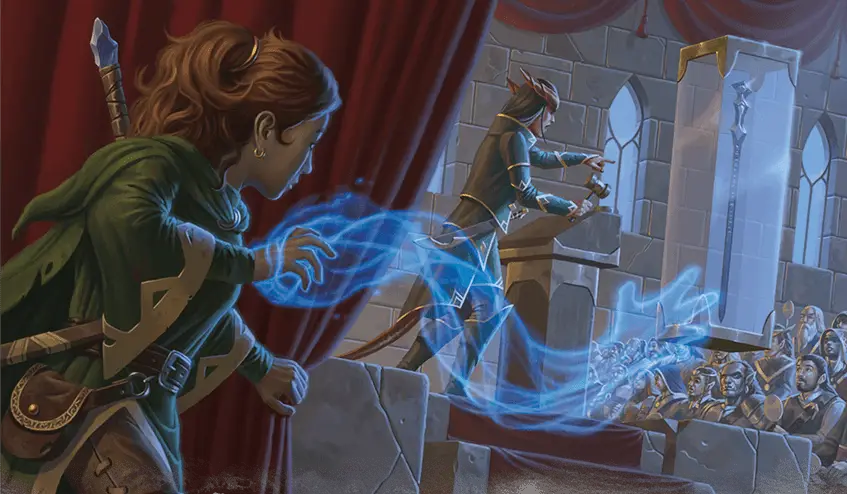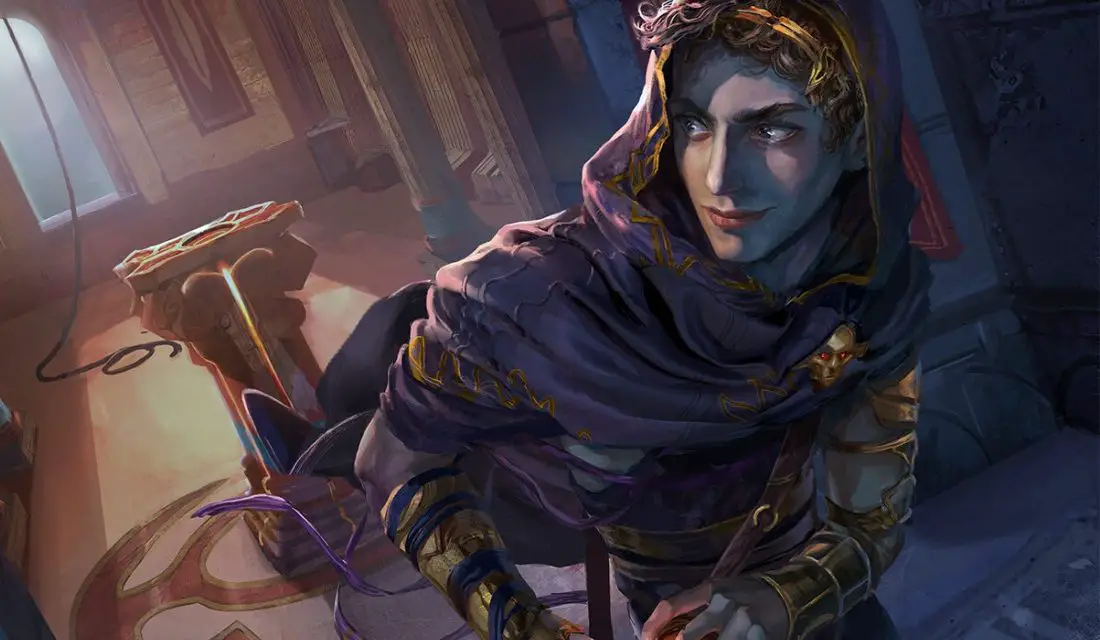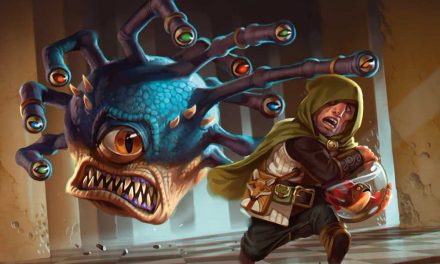Not all deities and the Clerics who worship them want to be a visible presence in the world. Operating behind the scenes, they prefer the freedom that comes with existing outside of such a system.
Trickery Clerics are among the most important servants of deities who preside over the domains of thieves, luck, chaos, and deception.
These characters use their powers to humble the prideful, free the imprisoned, and challenge authority.
If causing some chaos with charms and illusions sounds up your alley, there is a deity who is more than happy to welcome you!
This is the full subclass guide to the Trickery Cleric in D&D 5e!
What is the Trickery Cleric in D&D 5e?
It’s easy to view Clerics as priests and warriors who walk a straight and narrow path in service to their deity. Regardless of their chosen deity, there’s a certain level of order in how they view the world and operate within it.
But the Trickery Cleric takes another path…
In service to deities who preside over mischief, chaos, illusion, and theft, Trickery Clerics seek to challenge the established order of things around them.
Some may be content with pulling pranks or a general sense of rebellion. However, the especially clever ones work their way into positions where they can manipulate entire organizations or communities.
Most Trickery Clerics don’t operate out of malice. Instead, they simply seek to challenge authority, meaningless traditions, and the accepted “order of things” around them.
Deities commonly revered by Trickery Clerics include:
- Tymora, Goddess of Good Fortune
- Olidammara, God of Tricks, Rogues, Humor, Wine, and Revelry
- Garl Glittergold, Gnomish God of Luck, Trickery, and Protection
- Beshaba, the jealous sister of Tymora and Goddess of Misfortune
- The Traveler, God of Chaos, Deception, and Change in Eberron and Exandria
The Trickery Cleric appears as a subclass option in the 5e Player’s Handbook.
Role in the Party
It’s probably not surprising that a subclass built around trickery and illusion doesn’t exactly favor direct confrontation.
Whether in combat or out of it, Trickery Clerics are manipulators. They know that a well-placed whisper or perfectly planned prank can start a “domino effect” with huge repercussions.
As a Trickery Cleric, you’re primarily geared to offer support and utility to your party.
The Cleric spell list gives you plenty of ways to buff and heal your allies. Meanwhile, you’ll be gaining Trickery spells to help you trick and enchant others or make a quick escape if things get rough.
Trickery Clerics tend to be very versatile and individualistic in how they approach situations. Your positioning and exact role in the party are rarely going to become predictable.
You want to pay close attention to where you need to position yourself to have the most impact. Sometimes that might be towards the front of the party while other times it might see you hanging towards the backline.
The best value of the Trickery Cleric comes from being opportunistic and exploiting any opening you see. Of course, you’ve also got plenty of means to create that opening yourself if need be!

Trickery Cleric Features 5e
Fitting with the theme of the Trickery Domain, the feature you gain with this subclass are geared towards sowing confusion in combat.
The high points of the Trickery Cleric’s features are its spell list and unique use of Channel Divinity.
By the time your enemies realize that you’ve been pulling their strings throughout the entire fight, it will be too late for them!
Also Check Out: Using Turn and Destroy Undead in D&D 5e!
Trickery Domain Spells
Every Divine Domain (Cleric subclass) also comes with its own unique list of bonus spells. These are called Domain Spells.
You gain these Domain Spells when you hit the level on the table below. These spells are considered to always be prepared for you and they don’t count against the number of spells you can prepare each day.
Some Domain Spell lists might include spells that aren’t normally on the Cleric spell list. In these cases, the spell counts as a Cleric spell for you and uses your Wisdom modifier as the spellcasting ability.
So, let’s check out what you get for choosing the Trickery Domain!
| Cleric Level | Domain Spells |
| 1 | Charm Person, Disguise Self |
| 3 | Mirror Image, Pass Without a Trace |
| 5 | Blink, Dispel Magic |
| 7 | Dimension Door, Polymorph |
| 9 | Dominate Person, Modify Memory |
Thoughts on the Trickery Cleric Spell List
Charm Person can be incredibly helpful in dealing with social situations. Combine it with Disguise Self and a reasonably good bonus to your Deception/Persuasion rolls and you can cause untold chaos right from level 1!
Trickery Clerics aren’t as heavily armored as Clerics from other domains but Mirror Image greatly offsets that. It’s an excellent defensive spell!
In situations where the party needs to take a stealthy approach, Pass Without Trace is fantastic.
Blink is a fun and powerful (though somewhat unpredictable) spell. Nevertheless, you’ve got a 50% chance for enemies to not be able to target you between your turns. It’s a great way to heal up your party without provoking too much attention from enemies.
At least one person in every party should have Dispel Magic and that person is now you. Use this for dealing with ongoing spell effects or magical traps.
Polymorph is one of the best spells in the game with virtually no limit to how it can be used. Turning an enemy into a harmless turtle is fun, but so is turning a (willing) ally into a giant ape and letting them go full King Kong on the enemy!
When you need to reposition, escape, or just get across of chasm of death, Dimension Door is excellent. Plus, you can take a friend with you!
Dominate Person is a great way to make a new friend. If you’re fighting humanoid enemies, use this to convince the biggest threat to switch sides.
Don’t forget that you have Modify Memory. You probably won’t be using this very often, but it can get you out of trouble or open opportunities like few other spells can!
Blessing of the Trickster (Level 1)
When your party needs to be sneaky, it’s time for the Blessing of the Trickster!
As an action, touch a willing creature other than yourself to give it advantage on Dexterity (Stealth) checks. This blessing lasts for 1 hour or until you use this feature again.
If a member of your party is doing some scouting, this will really help them out.
Even though characters like Rogues or Way of Shadow Monks will almost certainly have proficiency in stealth, this helps them better avoid a bad roll!
However, this is also good if the whole party is having to be stealthy.
Characters like Paladins or Fighters wearing heavy armor tend to make a lot of noise. This is a great way to offset the disadvantage of trying to be sneaky in heavy armor!
Related: Advantage and Disadvantage in 5e Explained

Channel Divinity: Invoke Duplicity (Level 2)
As with all Clerics, your Divine Domain gives you a new option for how to use your Channel Divinity feature.
In the case of the Trickery Cleric, your enemies will be seeing double!
As an action, you create a perfect illusion of yourself that lasts for one minute or until you lose concentration.
The illusion appears in an unoccupied space that you can see within 30 feet of you. As a bonus action on your turn, you can move the illusion up to 30 feet to a space you can see, but it must remain within 120 feet of you.
For the duration, you can cast spells as though you were in the illusion’s space, but you must use your own senses.
Additionally, when both you and your illusion are within 5 feet of a creature that can see the illusion, you have advantage on attack rolls against that creature, given how distracting the illusion is to the target.
There’s a lot to this one, so let’s break it down…
Using Invoke Duplicity
Depending on your own creativity and the situation at hand, this feature can be very powerful. The duration is long enough that it should be able to last you for the entirety of most combats.
Just keep in mind that you’ll want to brush up on how concentration works. If you lose concentration, this effect ends!
Being able to confuse enemies with this is great as it is, but the real perk is that you can cast spells through your duplicate.
You’ll want to keep a keen eye on the strategy and flow in combat to know how to position your duplicate for the best effect. Keeping a duplicate near your allies for quick healing is always helpful, but it can also let you cast spells at enemies from other angles that they might not be guarded against.
If you’re finding yourself in melee range, this feature is also a great and reliable way to get advantage on your attack rolls.
However, Trickery Clerics aren’t quite as durable as the other more heavily-armored Cleric subclasses. While you could build your character around this, it’s just wise to know that you aren’t quite as at-home on the frontlines as your tougher party members.
As for how enemies interact with the duplicate in combat, I just use the same rules as Minor Illusion.
If an enemy can investigate the duplicate, they roll Investigation vs the Trickery Cleric’s spell save DC. If they attack it, the attack goes through it and they realize it’s an illusion but have wasted an attack.
Channel Divinity: Cloak of Shadows (Level 6)
Whether you need to change your position or make a quick getaway, going invisible is always handy.
As an action, you become invisible until the end of your next turn. You become visible if you attack or cast a spell.
The downside to this use of Channel Divinity is that you’re not invisible for very long at all. At most, you’re looking at 2 rounds of being invisible or a total of 12 seconds.
Since you lose invisibility when you cast a spell or make an attack, this will mostly be used for a quick little burst of needing to be invisible. Say if you’re trying to avoid someone chasing you or quickly slip past a guard.
Attacking from invisibility would give you advantage on your roll, but you can already get that (and more) with your Invoke Duplicity feature.
Generally speaking, you’ll get more use out of Invoke Duplicity with your Channel Divinity. Still, this can be handy in emergencies.

Divine Strike (Level 8)
Level 8 is when each Cleric subclass gets a buff to their damage output with either spells or melee attacks.
In the case of the Trickery Cleric, you’re getting the latter!
You may not get the Extra Attack feature as a Cleric, but your attacks will now hit harder!
Once on each of your turns when you hit a creature with a weapon attack, you can cause the attack to deal an extra 1d8 poison damage to the target.
When you reach level 14, the extra damage increases to 2d8.
As I say all the time, I’m the last one to ever gripe about being able to deal extra damage. In many cases, this is fun and reliable extra damage to help you bring the pain on your enemies!
But the only problem with this feature is the type of damage that it deals.
A huge amount of monsters are resistant or immune to poison damage. Demons, devils, green dragons, elementals, constructs, undead… You’re going to have a much harder time dealing with these enemies…
Make sure you’ve got some reliable cantrips like Toll the Dead or Sacred Flame in case you run into these enemies. They will be much more effective!
Improved Duplicity (Level 17)
Used well, Invoke Duplicity can infuriate enemies and give you a crazy level of control over the battlefield.
I hope you’ve been practicing your tactics with that feature because it’s about to get supercharged!
When you use Invoke Duplicity, you can create up to four duplicates instead of one.
As a bonus action on your turn, you can move any number of them up to 30 feet to a maximum range of 120 feet.
As far as capstone features go, I absolutely love this. It takes the core feature of the Trickery Cleric and dials it all the way up to 11.
This works just like your regular Invoke Duplicity, but you now have exponentially more options.
You should have no difficulty keeping at least one duplicate near your allies for quick and easy healing/buffs. Meanwhile, you can have the others distracting and confusing enemies.
As long as each of your duplicates is within 120 feet of you (which is pretty easy to accomplish), you’ve got 5 potential angles that you can attack enemies from.
The options here are limitless.
That will teach enemies to mess with a trickster!

Connections
Trickster Clerics are typically wild, chaotic, and unpredictable. But that doesn’t mean that they don’t have reasons behind what they do and causes that they care about.
While some can certainly be selfish, I think the bigger picture of the Trickery Domain goes beyond that.
Maybe it’s just me, but I get a strong “punk rock” vibe from the Trickery Cleric’s theme.
They see the world full of establishments and rules but they see how those establishments betray people and the rules don’t apply to everyone.
Humbling the prideful, stealing from the rich to give to the poor, or making a mockery of stuffy traditions are common things that Trickery Clerics enjoy doing.
But they can also bring great joy to others. People who enjoy a good prank or a certain air of whimsy will likely enjoy the company of a Trickery Cleric.
Because Trickery Clerics are so varied in their views and motivations, they’re possibly the easiest of the Cleric subclasses to work into any party or adventure.
Especially if the party also has an Arcane Trickster Rogue, there will be no shortage of shenanigans!
Is the Trickery Cleric Good?
The Trickery Cleric in D&D 5e is incredibly powerful in the hands of creative players who like to poke at the game’s world just to see what happens.
If you’re already more of an “instigator” type of player, you’ll take to this subclass like a fish takes to water.
That said, the Trickery Cleric is quite possibly the hardest subclass to play well in 5e.
To really get the best value out of the subclass’s features, you need to have a strong understanding of how 5e works as a system. You might also need to know how to manipulate your party (and even your DM on occasion!).
If you know those things, you’ll see just how amazing the spells and features you gain from the Trickery Domain are. You’ve got an entire palette of ways to cause mischief!
So, while newer players can certainly play a Trickery Cleric if they’re so inclined, it will be more of a challenge. But with creativity and embracing the unique learning curve that comes with the Trickery Domain, you’ll have a great time!
If you’re looking for a masterclass in what Trickery Clerics are capable of, I would also strongly recommend checking out Laura Bailey’s character of Jester Lavorre in Critical Role’s second season.
Want more? Check out my ranking of every Cleric subclass in D&D 5e!
Conclusion – Trickery Cleric in D&D 5e
I guess it makes sense, but the Trickery Cleric is one of the most difficult Cleric subclasses to generalize. With most subclasses, there’s a certain element of “this is how this character plays” but the Trickery Cleric is a blank canvas.
The spells and features are more like a toolkit that gives you tons of new ways to interact with the game and story.
If you poke and prod at the game world, you’ll be surprised what kind of “out of the box” solutions/antics you’ll stumble into! As someone who really loves that in my tabletop games, I just love the potential that the Trickery Cleric offers.
But I hope you’ve found this guide to the Trickery Cleric in D&D 5e helpful!
Got questions or a character concept you’d like to share? Let’s chat in the comments!
Want all the latest player guides, DM tips, news, reviews, and more for D&D 5e? Sign up for the Tabletop Joab newsletter below!
You can also follow me on Facebook and Twitter.
If you found this article helpful and want to support the site, you can buy me a coffee here! (It’s not expected, but very appreciated!)









